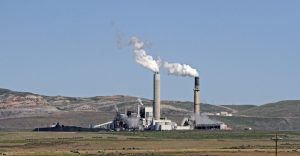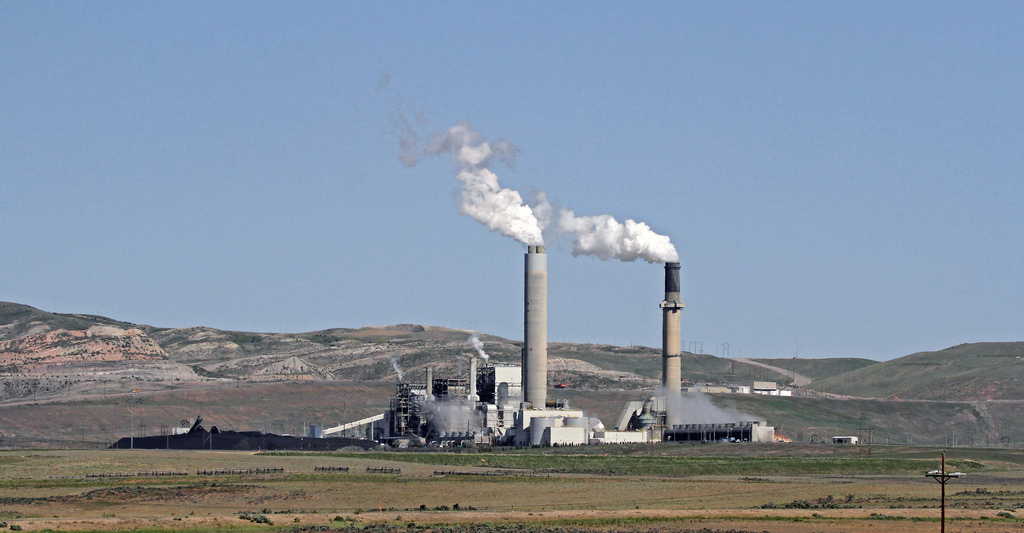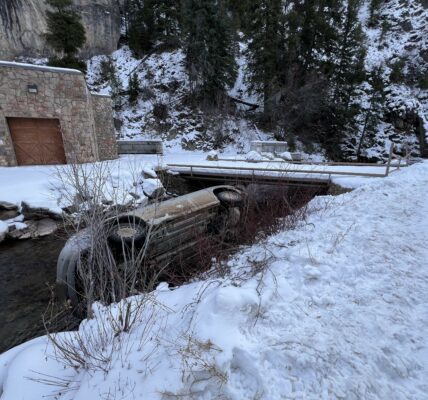PacifiCorp: Early closure of Wyo coal plants saves $599 million
By Angus M. Thuermer Jr., WyoFile.com

PacifiCorp and its 1.9 million utility customers could save $599 million by retiring several coal-fired electrical generating units in Wyoming and elsewhere — including early closures at the Jim Bridger and Naughton plants — according to a company analysis unveiled last week.
In public meetings in Portland and Salt Lake City, PacifiCorp unveiled 30 business options or portfolios it will use to build its Integrated Resource Plan — the mix of sources from which it will deliver power to customers — in October. That plan will guide the utility, and determine the fate of its 25 power-generating units.
A PacifiCorp analysis called “Portfolio 46” predicts the largest savings: $599 million achieved by mothballing the entire Jim Bridger Plant in 13 years, closing the Dave Johnston Plant near Glenrock in eight years and shuttering two units at the Naughton Plant near Kemmerer in six years, along with other changes.
LINCOLN COUNTY COMMISSION SAYS NAUGHTON 1 & 2 TO SHUT DOWN IN 2025
In addition to costs, the 30 portfolios will be evaluated for risk, reliability, carbon emissions, customer preference and other factors. The company compared the 30 analyses to “Portfolio 1,” the benchmark that follows existing priorities.
If it continued under the current IRP, PacifiCorp would retire two units at Naughton a decade from now. It would shut down the four units at Dave Johnston east of Casper in eight years as already anticipated. The company would retrofit two Jim Bridger units and then retire the entire plant in 2037 — 18 years from now. Wyodak outside Gillette would go offline in two decades.
But each of the new options offer millions of dollars in savings compared to the company’s current course, according to a PowerPoint presentation delivered by PacificCorp at last week’s meetings. Some call for one unit at Naughton to be converted to burning natural gas instead of coal.
“Pacificorp’s own analysis shows that keeping aging coal plants running will mean higher electricity bills for Wyoming families and businesses,” Connie Wilbert, director of Sierra Club’s Wyoming chapter, said in a statement. Her organization has campaigned against coal burning.
“Wyoming can no longer keep its head in the sand on the declining economics of coal power,” she wrote. “Now is the time to help coal-dependent communities in Southwest Wyoming make an orderly transition away from coal rather than risking the sort of sudden job losses that we’ve seen in recent coal bankruptcies.”
At the sprawling Jim Bridger Plant with its landmark 500-foot high smoke stacks, workers like supervising engineer Bernie Caulfield understand coal’s decline and the effects on sister communities like Gillette. The plant and associated coal mines employee some 800 people in southwest Wyoming and can produce enough electricity to power 1.76 million homes, according to WyoFile calculations.
Of PacifiCorp’s 1.9 million customers, though, only 140,000 live in Wyoming.
“It’s pretty obvious they feel threatened,” Caulfield told WyoFile of his colleagues while traversing dusty catwalks at Jim Bridger, stories above the ground, on a recent tour of the facility. Miners have watched sudden bankruptcies close two surface mines in eastern Wyoming and with each troubling development, Caulfield said, they ask “what does it mean for my employment?”
Caulfield grew up in Anaconda, Montana, a copper mining town that withered and now deals with legacy pollution. That experience left him with mixed emotions, he said.
“It provided jobs for lots of people, lots of families,” he said. And now Jim Bridger’s future too becomes an “economic calculation,” he said.
“People’s fathers and grandfathers have worked here,” Caulfield said at Jim Bridger. Today’s workers, “they just want to live their lives.”
Jim Bridger workers also understand who they ultimately serve — consumers spread across California, Oregon, Washington, Idaho, Utah and Wyoming who dictate to their supplier what kinds of power they want. In an age of climate change, that choice is increasingly solar and wind power instead of coal.
“They’re our customer,” said Mike Rodriguez, an operator at Jim Bridger’s control room who monitors a bank of computer screens and associated keyboards. “They’re our priority. They come first.”
In the plant manager’s office, Jim Bridger’s managing director Rick Tripp shoots straight with his “family” of employees, he said. Plaques recognizing contributions to community service organizations, plus dozens of pictures of his fawn boxers and a couple of shots of his sleek Corvette adorn his office walls.
“We are very open,” Tripp said about communicating PacifiCorp’s plans. “We have regular meetings with the people … almost every month.”
Despite increasing use of solar and wind power, layoffs at Jim Bridger are uncommon, he said. “We won’t eliminate people. We do it through attrition.”
In troubled times, “we’re trying to do as much as we can for our employees,” Tripp said. But, he added, “we have to support our customers.”
PacifiCorp’s charge is to offer those customers power based on reliability, risk, cost and preferences, among other factors. In the new dynamic, that might mean closing an expansive plant that otherwise seems to be humming along splendidly.
“If you talk to them today,” Tripp said of the workers, “they’re still very proud. They want to see these plants run.”
At the adjacent Bridger Mine, Manager of Technical Services Scott Palmer mulled the future as he drove over reclaimed mine land. He stopped the truck to answer a question and explain that he’s approaching retirement. However, if he were starting his career, he said, “I wouldn’t pick this as a profession.”
The IRP PacifiCorp chooses in October will largely determine the future of PacifiCorp’s fleet of facilities. Meantime, a proposal for operating Jim Bridger within the existing framework is being met with controversy.
The company recently requested Wyoming regulators to allow it to cut production at Jim Bridger to meet Clean Air Act rules. Until this year, the utility had instead planned on investing $280 million in pollution controls to meet federal regional haze requirements.
The state Department of Environmental Quality has supported the request and expects to submit the issue to the federal EPA for approval. PacifiCorp told the DEQ it would reduce coal consumption by about 9.3% compared to current operations, according to WyoFile calculations.
The proposed reduction will bring “economic harm … decreased tax revenues, reduced special use taxes, and potential loss of jobs,” a coalition of four counties’ commissioners wrote to the DEQ in a five-page letter.
The letter is one of three DEQ received on the PacifiCorp proposal to forego the $280 million in pollution controls in favor of reducing the plant’s output to 76.3% of capacity.
Wyoming’s DEQ agrees with PacifiCorp’s request that no additional pollution controls are needed at the Jim Bridger and that the company’s short-term plans “provide enforceable emission limits,” and meet required federal regional haze goals.
Sweetwater, Lincoln, Uinta and Sublette county governments say the PacifiCorp request to Wyoming regulators can’t replace the existing state plan for regional haze. That plan requires installation of “selective catalytic reduction” pollution controls on units 1 and 2 at Jim Bridger. Units 3 and 4 of the 4-unit plant already have the systems.
Instead of spending $280 million on the additional controls, the company wants to rejigger its measuring protocol as it throttles down Jim Bridger output. Under its proposal to Wyoming DEQ, PacifiCorp would essentially measure emissions from the entire plant across a rolling 30-day-window instead of tracking specific emissions from each of the four coal-burning boiler units.
Commissioners said the plan isn’t good for residents’ health. The DEQ published county comments on its website following a records request by the Powder River Basin Resource Council.
“[T]he Jim Bridger Plant will still emit pollutants into the air on the days the plants run and … these daily emissions will still adversely effect [sic] air quality and human health,” the commissioners’ letter reads.
“The Coalition … considers PacifiCorp’s request to run the plant less to meet emissions standards as a way to evade the original [state] requirements without addressing public health and all air quality issues,” the local governments wrote. Also, “running the Jim Bridge Plant less will reduce coal mining and greatly impact Sweetwater County and the region.”
In addition to the county commissioners’ objections the Wyoming DEQ also received letters from the federal Environmental Protection Agency and a bloc of three conservation groups.
EPA wrote two pages of comments, making 15 specific points, including a request that Wyoming regulators state whether PacifiCorp’s proposed “voluntary measures” will be enforceable.
The Powder River Basin Resource Council, Sierra Club and National Parks Conservation Association together filed 30 pages that included assertions that PacifiCorp is proposing an “illegal about face.”
PacifiCorp’s request to forego pollution controls “must be denied,” the groups wrote because of “longstanding agency determinations requiring [selective catalytic reduction] at units 1 and 2 of the Jim Bridger Power Plant.”
DEQ made an inadequate review of the company submission, the groups claim. PacifiCorp’s proposal is unenforceable, would increase nitrous oxide and sulfur emissions and suffers from internal contradictions, the conservationists assert.
In all, the groups made 10 major points, including that the proposal is unlawful. Citing “serious flaws” in the reassessment, Wyoming’s conclusions are “technically deficient, and as such invalid,” the letter reads.







